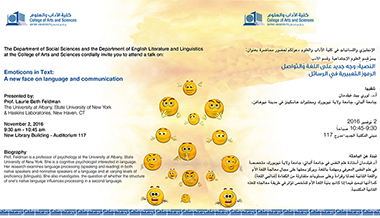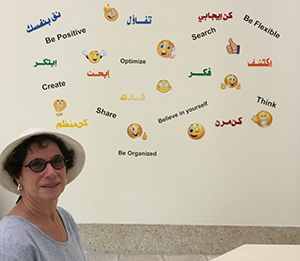Emotional Pictures
Is that a smiley face or a smirk?
 |
|
Posters for Feldman's colloquium in the Women's College at the University of Qatar in Doha last week. |
ALBANY, N.Y. (Nov. 9, 2016) – Emojis. The smiley face. The angry face. The wow! face. We think we all know what they mean.
Psychology professor Laurie Beth Feldman knows differently.
“In fact, there are differences in the choices of emoticons across languages, just as there are differences in the choice of words that people of different languages use,” she said. “The sense of a word can differ by context and it is almost certain that the same applies to emoticons. Emotions are universal but their expression is not always.”
Feldman gave a well-attended colloquium last week in the Women’s College at the University of Qatar in Doha, where she was warmly welcomed by faculty and students.
She recently asked students whose first language is Arabic to give an example of an emoticon that does not translate well. They would not use this smiley :) to indicate happiness or joy. They said they use it for something more superficial and maybe even to hide anger or sarcasm.
Feldman, a cognitive psychologist interested in language, joined the UAlbany faculty 26 years ago. She examines language processing (speaking and reading) in both native speakers and non-native speakers of a language with special attention to word structure, such as how to form the past tense of verbs (ie: walked has an “-ed” but ran does not).
“The smiley has multiple meanings, even within a language. The classic example is to indicate that you intend to be humorous or sarcastic by including a smiley just as one might smile if conversing person-to-person,” she said. “People also use emoticons to gain consensus. It would be the analog of saying, ‘Right?’ or ‘You know what I mean?’ in a spoken conversation.
Feldman reported about the behaviors of adult scientists who do not speak the same first language and who worked together for four years, examining how they communicated remotely to control a telescope. She found they alter their use of emoticons and vocabulary depending on whom they are talking to.
“This style of coordination across speakers has been documented for vocabulary, grammar, emotions, gestures and now emoticons in bilingual speakers,” Feldman said.
The paper is now under review for publication. (Under review, Bilingualism, Language and Cognition, with co-authors Cecilia R. Aragon, Nan-Chen Chen and Judith F. Kroll.)
 |
|
Feldman in front of a wall of emojis in the Women's College at the University of Qatar. |
Some of Feldman’s work on emoticons across different languages is used in the Psychology of Languages courses she teaches at UAlbany to demonstrate how we learn about behavior by analyzing patterns in big data. She also directs the undergraduate honors program in psychology.
Feldman was invited to Qatar by her host, Yousri Marzouki, who is from Aix-Marseille University in France and has a visiting teaching position at the Women’s University. She knew him from a panel she organized last year at the American Association for the Advancement of Science’s (publisher of the journal Science) annual meeting in San Jose, Calif.
The two researchers have begun to collaborate on analyzing tweets from the Paris attacks in 2015.
“We collected 250,000 tweets from the Arab attack in February 2015,” Feldman said. “We analyze patterns, like do people who tweet with an “I” pronoun (I, me, my, mine) use more words associated with excitement (like praise, freedom, abuse and betrayal) than people who tweet with a “we” pronoun (we, our, ours),” Feldman said. Marzouki, Feldman, her former student Samira Shaikh and current graduate student Eliza Barach are analyzing those tweets.
![]() For more news, subscribe to UAlbany's RSS headline feeds
For more news, subscribe to UAlbany's RSS headline feeds
A comprehensive public research university, the University at Albany-SUNY offers more than 120 undergraduate majors and minors and 125 master's, doctoral and graduate certificate programs. UAlbany is a leader among all New York State colleges and universities in such diverse fields as atmospheric and environmental sciences, business, education, public health,health sciences, criminal justice, emergency preparedness, engineering and applied sciences, informatics, public administration, social welfare and sociology, taught by an extensive roster of faculty experts. It also offers expanded academic and research opportunities for students through an affiliation with Albany Law School. With a curriculum enhanced by 600 study-abroad opportunities, UAlbany launches great careers.


